
Finally! NASA Mars Rover has solved its previously reported pebble issue.
Despite removing the blockage, the rover team reported that there are pebbles remaining. However, they assured people that it will not create a serious issue.
Apart from this good news, the NASA Hubble Space Telescope also captured a stunning photo of "Sails of Stars."
NASA Mars Rover Solves Problematic Pebble Issue
Through a NASA Mars Rover GIF posted on Twitter, it was revealed that the two pebbles blocking the rover from using it sample tube were removed.
With a turn of my bit carousel, I’ve cleared the two pebbles that likely blocked me from processing my latest sample tube. Two smaller ones remain lower down, but may not be an issue (and might fall out just by driving). Onward!
— NASA's Perseverance Mars Rover (@NASAPersevere) January 21, 2022
Details: https://t.co/kHxq9S2GXx #SamplingMars pic.twitter.com/fpH7gFcH08
Following the said announcement, numerous Twitter users congratulated the rover. As of writing, the GIF garnered more than 3,900 likes.
For background information, late last year, several pebbles got in the way of NASA's Perseverance rover's sampling process when it tried to move a tube full of rock into its internal handling system, per Cnet.
As a result, the rover team had to come up with new ideas to remove the blockage.
The space agency emphasized that on Monday, January 17, the WATSON camera captured photos of the bit carousel and its pebbles, as well as images below the rover to determine what was beneath before any recovery tactics could be implemented.
On the same Martian date, NASA turned the bit carousel 75 degrees before reverting it to its original place.
"WATSON imaging showed the two upper pebbles were ejected during the process. Tuesday night we also received the second set of under-rover images, which show two new pebbles on the surface, indicating the ejected pebbles made it fully through bit carousel and back onto the surface of Mars as planned," the space agency continued on the blog post.
Read Also : Elon Musk Annoyed by NFT Profile Pictures, Wants Twitter to Block Crypto Scammers Instead!
Despite the fact that it removed two pebbles, it is worth noting that there are remaining stones found beneath the bit carousel of NASA Mars Rover. However, the rover team explained that the preliminary tests on the testing ground on Earth indicated that the two leftover stones may not create a serious issue with bit carousel operation.
The team added that they are still analyzing and testing this occurrence to be sure.
In another report, NASA Hubble Space Telescope captured a sail of stars.
NASA Hubble Space Telescope Captures Stunning Photo of NGC 3318
The NASA Hubble image posted on Twitter showed a stunning photo of galaxy NGC 3318.
Raise your cosmic sails ⛵
— Hubble (@NASAHubble) January 21, 2022
This #HubbleFriday image shows the galaxy NGC 3318, which is part of the constellation Vela…which was originally part of a much larger constellation known as Argo Navis after the ship Argo from Greek mythology!
Read more: https://t.co/XcXphx94J9 pic.twitter.com/R1sR0xJsSg
To provide detailed information, this spiral galaxy is around 115 million light-years away from Earth and it is located in the constellation Vela, per another NASA report.
Vela was once a part of a much bigger constellation known as Argo Navis, named after the legendary Greek ship Argo, but this complex constellation appeared to be too large to manage. Carina, Puppis and Vela were named after different portions of the Argo Navis.
Furthermore, the outer margins of NGC 3318 resemble the flowing sails of a ship in a mild breeze.
DevDiscourse added that despite its peaceful look, the galaxy previously hosted a massive supernova, which was discovered by an amateur astronomer in the year 2000.
The distance between NGC 3318 and Earth, determine that the original supernova must have happened in or around 1885. This was also the year that 19th-century scientists watched the only supernova identified in our neighboring galaxy Andromeda.









